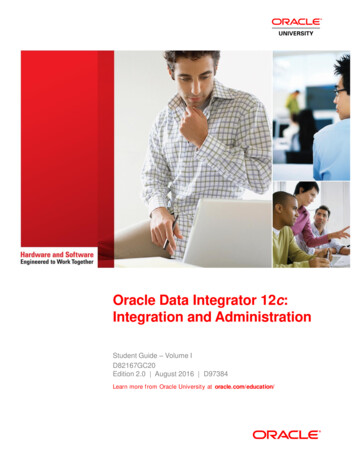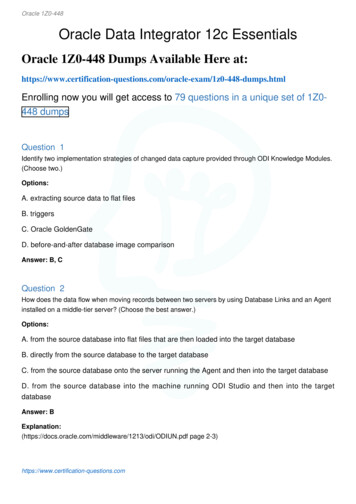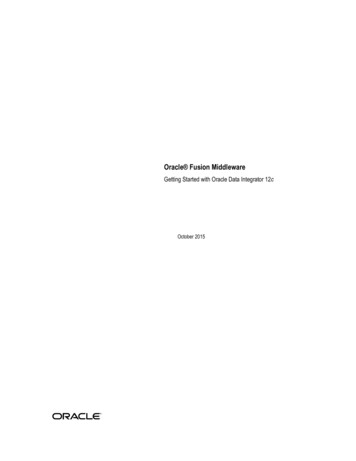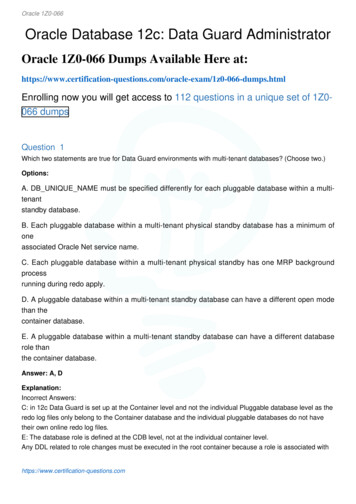
Transcription
Oracle 1Z0-066Oracle Database 12c: Data Guard AdministratorOracle 1Z0-066 Dumps Available Here exam/1z0-066-dumps.htmlEnrolling now you will get access to 112 questions in a unique set of 1Z0066 dumpsQuestion 1Which two statements are true for Data Guard environments with multi-tenant databases? (Choose two.)Options:A. DB UNIQUE NAME must be specified differently for each pluggable database within a multitenantstandby database.B. Each pluggable database within a multi-tenant physical standby database has a minimum ofoneassociated Oracle Net service name.C. Each pluggable database within a multi-tenant physical standby has one MRP backgroundprocessrunning during redo apply.D. A pluggable database within a multi-tenant standby database can have a different open modethan thecontainer database.E. A pluggable database within a multi-tenant standby database can have a different databaserole thanthe container database.Answer: A, DExplanation:Incorrect Answers:C: in 12c Data Guard is set up at the Container level and not the individual Pluggable database level as theredo log files only belong to the Container database and the individual pluggable databases do not havetheir own online redo log files.E: The database role is defined at the CDB level, not at the individual container level.Any DDL related to role changes must be executed in the root container because a role is associated withhttps://www.certification-questions.com
Oracle 1Z0-066an entire CDB. Individual pluggable databases (PDBs) do not have their own roles.Reference: https://docs.oracle.com/database/121/SBYDB/create ps.htm#SBYDB5213Question 2Which two are prerequisites for configuring flashback database for Oracle 12c databases, in a Data Guardenvironment? (Choose two.)Options:A. A flash recovery area must be configured.B. The database must be in MOUNT state.C. The database must be in ARCHIVELOG mode.D. A far sync instance must be configured to flash back a standby when the primary has beenflashedback.E. The Data Guard Broker must be used.Answer: A, CExplanation:Configure the following database settings before enabling Flashback Database:You must have a fast recovery area enabled, because flashback logs can only be stored in the fastrecoveryarea.Your database must be running in ARCHIVELOG mode, because archived logs are used in the FlashbackDatabase operation.For Oracle Real Application Clusters (Oracle RAC) databases, the fast recovery area must be in aclusteredfile system or in ASM.Reference: .htm#BRADV582Question 3You are required to change the Data Guard Configuration protection mode from MAXPERFORMANCE toMAXAVAILABILITY using Enterprise Manager Cloud Control.Which two are true about this change? (Choose two.)Options:A. If the primary database cannot write its redo to at least one synchronized standby database,then theprotection level remains unchanged.https://www.certification-questions.com
Oracle 1Z0-066B. The primary database instance will remain up and running, if it cannot write redo to at least onesynchronized standby database.C. Transactions will not commit until all redo data needed to recover those transactions are writtento theonline redo log, and to the standby redo log on at least one synchronizes standby database.D. Fast start failover can be enabled when making the chance.E. Real time apply will be automatically turned on.Answer: B, CExplanation:Maximum AvailabilityThis protection mode provides the highest level of data protection that is possible without compromising theavailability of a primary database. Transactions do not commit until all redo data needed to recover thosetransactions has been written to the online redo log and to at least one synchronized standby database.If the primary database cannot write its redo stream to at least one synchronized standby database, itoperates as if it were in maximum performance mode to preserve primary database availability until it isagain able to write its redo stream to a synchronized standby database.Reference: https://docs.oracle.com/cd/B28359 01/server.111/b28294/protection.htmQuestion 4Which four database parameters might be affected by or influence the creation of standby databases?(Choose four.)Options:A. DB NAMEB. ARCHIVE LAG TARGETC. COMPATIBLED. DB FILE NAME CONVERTE. DB UNIQUE NAMEF. FAL SERVERG. STANDBY ARCHIVE DESTAnswer: A, D, E, FExplanation:A: DB NAMEOn a primary database, specify the name used when the database was created. On a physical standbydatabase, use the DB NAME of the primary database.https://www.certification-questions.com
Oracle 1Z0-066C: Ensure the COMPATIBLE initialization parameter is set to the same value on both the primary andstandby databases. If the values differ, redo transport services may be unable to transmit redo data fromthe primary database to the standby databases.D: DB FILE NAME CONVERTSpecify the path name and filename location of the primary database data files followed by the standbylocation. This parameter converts the path names of the primary database data files to the standby data filepath names.E: DB UNIQUE NAMESpecify a unique name for each database. This name stays with the database and does not change, even ifthe primary and standby databases reverse roles.F: FAL SERVERSpecify the Oracle Net service name of the FAL server (typically this is the database running in the primaryrole).Reference: https://docs.oracle.com/database/121/SBYDB/create ps.htm#SBYDB4720Question 5You must propose an Oracle Data Guard configuration for a database supporting an OLTP workload thatmeets these permanent requirements:1. Data loss is not permitted.2. Read-only applications should not connect to the primary database instance.Additionally, there are these requirements, only one of which is ever done at any one time:3. It should be possible to apply and test designated patches with a minimum amount of downtime.4. Upgrading to a new database release should be performed with the least possible amount of downtime.5. New application software releases should be tested against an exact up-to-date replica of the productiondatabase.You propose a primary database with one physical standby database configured in Maximum Protectionmode.Which requirements do you meet?Options:A. 2, 3, 4, and 5B. 1, 2, 3, 4, and 5C. 1 and 2D. only requirement 5E. only requirement 1Answer: CExplanation:Maximum Protection mode ensures that zero data loss occurs if a primary database fails.Because this data protection mode prioritizes data protection over primary database availability, Oraclehttps://www.certification-questions.com
Oracle 1Z0-066recommends that a minimum of two standby databases be used to protect a primary database that runs inmaximum protection mode to prevent a single standby database failure from causing the primary databaseto shut down.Incorrect Answers:A, D: Maximum Protection mode ensures that zero data loss occurs if a primary database fails.Reference: https://docs.oracle.com/cd/B28359 01/server.111/b28294/protection.htmQuestion 6You must configure an Oracle Data Guard environment consisting of:1. A primary database2. Three Physical Standby DatabasesYou must meet these requirements:1. A designated physical standby database should become the primary database automatically wheneverthe primary database fails.2. The chosen protection mode should provide the highest level of protection possible without violating theother requirement.Which redo transport mode and protection mode would you configure to meet these requirements?Options:A. SYNC NOAFFIRM and Maximum ProtectionB. SYNC NOAFFIRM and Maximum AvailabilityC. ASYNC and Maximum PerformanceD. SYNC AFFIRM and Maximum AvailabilityE. SYNC AFFIRM and Maximum ProtectionAnswer: DExplanation:The Maximum Availability protection mode provides the highest level of data protection that is possiblewithout compromising the availability of a primary database.When a transport is performed using SYNC/AFFIRM, the primary performs write operations and waits foracknowledgment that the redo has been transmitted synchronously to the physical standby and written todisk. A SYNC/AFFIRM transport provides an additional protection benefit at the expense of a performanceimpact caused by the time required to complete the I/O to the standby redo log.Incorrect Answers:B: When a transport is performed using SYNC/NOAFFIRM, the primary performs write operations andwaitsonly for acknowledgement that the data has been received on the standby, not that it has been written todisk. The SYNC/NOAFFIRM transport can provide a performance benefit at the expense of potentialexposure to data loss in a special case of multiple simultaneous failures.Reference: https://docs.oracle.com/cd/B28359 tification-questions.com
Oracle 1Z0-066Question 7Your Data Guard environment has two remote physical standby databases.Client applications use the local naming method to connect to the primary database instance.You want applications to automatically connect to the new primary database instance in case of aswitchover or a failover.Which will fulfill this requirement?Options:A. Create a database service on each standby database that is started automatically by a trigger,when thedatabase role is PRIMARY; modify the connection descriptors used by client applications toinclude allthe standby hosts and connect to the database instance using that service name.B. Create a database service on the primary database that is started automatically by a trigger,when thedatabase role is PRIMARY; modify the connection descriptors used by client applications toinclude allthe standby hosts and connect to the database instance using that service name.C. Set the INSTANCE NAME parameter identically on all databases; modify the connectiondescriptor onclient applications to include all the standby hosts and connect to the database instance using thatservice name.D. Set the DB NAME and DB UNIQUE NAME identically on all databases; modify the connectiondescriptors on client applications to include all the standby hosts and connect to the databaseinstanceusing that service name.Answer: AExplanation:Reference: http://docs.oracle.com/cd/B19306 n 8Examine the Data Guard configuration:DGMGRL show configuration;Configuration AnimalsProtection Mode: MaxPerformanceDatabases:dogs Primary databasehttps://www.certification-questions.com
Oracle 1Z0-066sheep Snapshot standby databasecats Snapshot standby databaseFast-Start Failover: DISABLEDConfiguration Status:SUCCESSYou receive an error while attempting to raise the protection mode to Maximum Availability:DGMGDRL edit configuration set protection mode as maxavailability;Error: ORA-16627: operation disallowed since no standby databases would remainto support protection modeFailed.Identify two statements that you can execute, either one of which will enable successful raising of theprotection mode to Maximum Availability. (Choose two.)Options:A. DGMGRL convert database sheep to physical standby;B. DGMGRL convert database cats to physical standby;C. DGMGRL edit database dogs set property LogXptMode fastsync;D. DGMGRL edit database sheep set property LogXptMode fastsync;E. DGMGRL edit database cats set property LogXptMode sync;Answer: D, EQuestion 9You administer a Data Guard environment with a primary and two physical standby databases.One of the physical standby databases is used for reporting and is on the same host as the primarydatabase.The other physical standby database is remote, used for disaster recovery and REDO is routed to it via afarsync instance.Backups are offloaded to the remote physical standby.Which three are true concerning the management of archive logs in this Data Guard configuration?(Choose three.)Options:A. Archive logs on the primary database may be deleted once they are applied on all standbydatabases.B. Archive logs on the primary database may be deleted once they are shipped on all standbydatabases.C. The deletion policy for archive logs on the remote physical standby should be set so thathttps://www.certification-questions.com
Oracle 1Z0-066archived logsare deleted once they backed up at least once on the remote physical standby database.D. The deletion policy for archive logs on the remote physical standby should be set so thatarchived logsare deleted once they are applied on all standby databases.E. Archive logs on the primary database may be deleted once they are archived locally to disk.Answer: A, D, EExplanation:Reference: ility/farsync-2267608.pdfQuestion 10Your Data Guard environment has one physical standby database using Real-Time Query.Two sequences have been created by these SQL statements:create sequence a global;create sequence b session;Neither sequence has been used since being created.Session 1 connects to the primary database instance and issues these two SQL statements:SELECT a.nextval FROM DUAL;SELECT b.nextval FROM DUAL;Then session 2 connects to the physical standby database instance and issues the same SQL statements.What output will be seen for session ons.com
Oracle 1Z0-066Answer: AWould you like to see more? Don't miss our 1Z0-066 PDFfile tions.com
Which two are prerequisites for configuring flashback database for Oracle 12c databases, in a Data Guard environment? (Choose two.) Options: A. A flash recovery area must be configured. B. The database must be in MOUNT state. C. The database must be in ARCHIVELOG mode. D. A far sync instance must be configured to flash back a standby when the primary has been
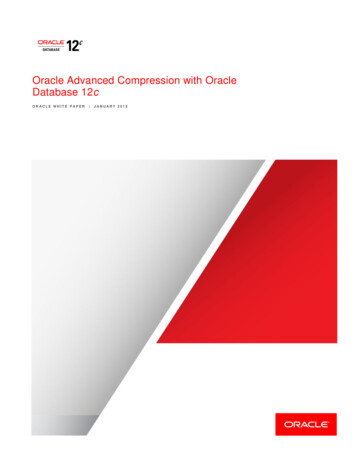


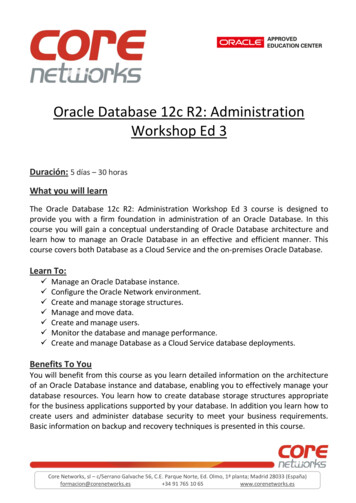
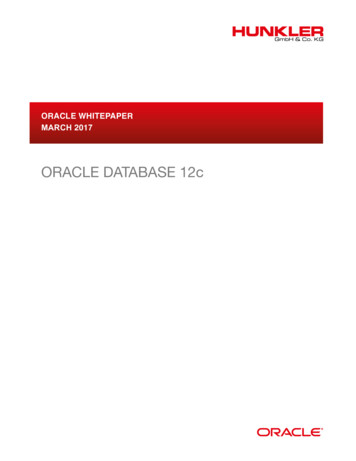

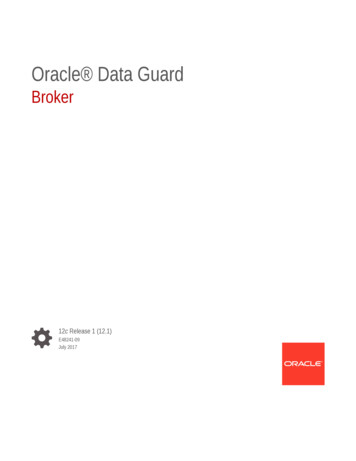
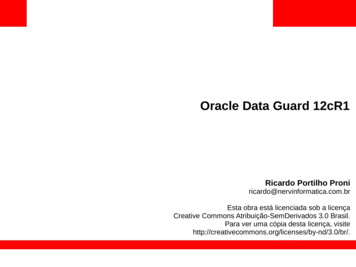
![[1]Oracle Data Integrator Studio Online Help 12c (12.2.1.1)](/img/5/odish.jpg)
